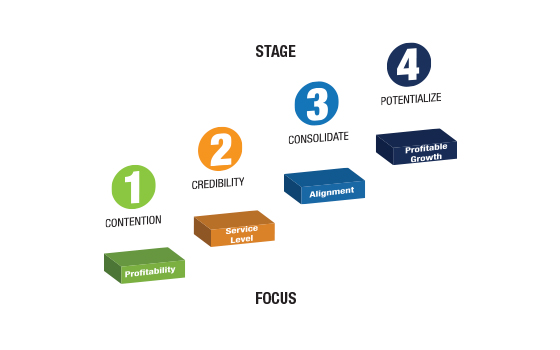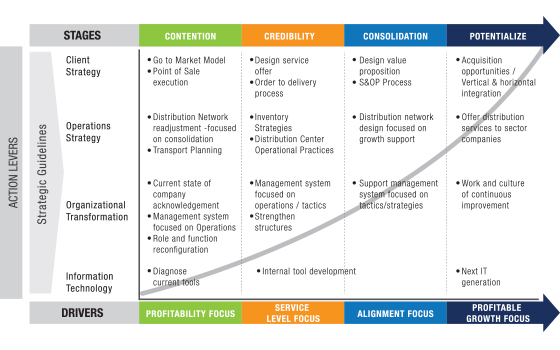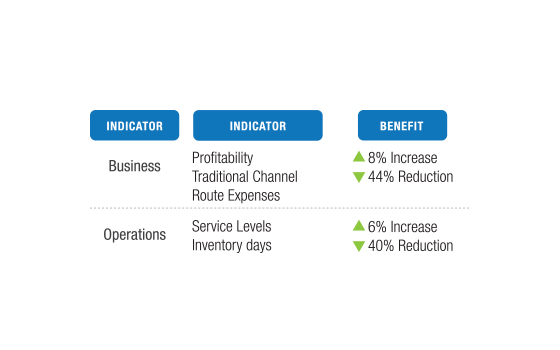It doesn’t come as a surprise for any executive that one of the main current challenges is profitable growth but, how can we take the right decisions to make sure we are on the right path? To answer this question, we’ll analyze the success case study of a company that changed its negative balance for profitable growth, while using a combined focus of client & operations strategies. Sintec has collaborated closely with this business in recent years, interacting in topics that range from process design to ushering its implementation.
Throughout this article, we will show the company’s evaluation during its growth-focused transformation process, the results achieved and lessons adaptable to any company.
What went wrong in the company that led to a negative balance?
Starting point – Disjunction between strategic intentions and its supporting competencies and capacities.
The business we will be studying takes part on the fast-moving consumer goods industry, with three main sales channels: retail, modern & wholesale. Although the company has national presence, the lack of alignment among its skills and capacities put a barrier on its growth.
At the beginning of our collaboration, the company had designed a series of strategic intentions, aligned to pursue growth & profitability:
- Participation improvement in the traditional channel, aiming at higher volume, less dependency on the modern channel and raise cash flow.
- Price increase to reduce impact of raw material costs, in case exchange rates would vary greatly.
- Effort ignition of product exports, with the objective of increasing volume & obtaining foreign exchange.
- Production flexibility achievement to extend product freshness, reduce inventory cycles and avoid waste away.
- Guarantee a Service Level higher than 95%.
These objectives might seem right at first glance, but the negative balance spoke loud and clear. Although an organic growth through emphasis on operative efficiency was pursued, when trying to set it down with courses of action and in the day-by-day execution, the result was an outright destruction of value.
Regarding the client strategy, the main area of opportunity was in the way the sales channels were being operated.
5 Main Flaws:
- Incorrect client classification and lack of segmentation.
- Use of new market routes without defining the kind of clients sought, nor processes to assure their profitability.
- Effort underestimation to participate in the traditional channel. This involves higher operative efficiency and a deep need for guidance from the company, to achieve the desired profitability.
- Value proposition without differentiating by store format, nor aligned among the different areas in the company.
- Inconsistent execution at points of sale.
When talking about operations strategy, the foremost opportunity area was centered in the lack of management and understanding of serving costs.
5 Main Flaws:
- Lack of supply chain costs optimization.
- Important investments in infrastructure in areas where there was no market growth.
- Inventory planning without segmenting by neither product nor inventory location.
- Elements of the supply chain were not linked, because there was no trust in product stocking.
- Organizational departments –Purchasing, Production, Inventory Planning and Transport– were after their own objectives and not the company’s.
In a similar way, when it comes to skill development focused on the organization, the company lacked an effective management system, which could align the organization with the strategic objectives of the firm. In the same line, the committee’s priorities and vision would not permeate throughout the organization, through its official communication channels.
When analyzing the competency development in information technologies, the company acquired and advanced tool – an ERP– that hadn’t been implemented because of an absence of processes and resources for its development.
To summarize, the organization didn’t have the skills and capacities to execute the strategic alignments that had been planned, which lead to suffering from negative sales impacts, costs, spending and investments, and thus, to a state of “red numbers” that needed immediate actions.
How did the company evolved to reach its goals?
Boarding for Profitable Growth – Transformation Process based on a client and operations strategy.
For the second phase of the evaluation, we divided the transformation process strategy in 4 stages, each one with a specific focus to guarantee a positive impact in the business evolution.
First stage: Contention
Objective: Stop profitability loss.
Strategy: Implement a strict program of operating expenses reduction, as well as setting a base for operative discipline to ease the process complexity through basic but consistent management.
Second stage: Credibility
Objective: Generate internal and external credibility.
Strategy: Offer higher Service Level and Customer Service. Position Operations as an area that can respond to complexity and challenges from a Commercial Department.
Third stage: Consolidation
Objective: Consolidate organizational work and optimize the value proposition.
Strategy: Align and synchronize the joint work of the organization (Commercial & Operations areas) with common indicators, as well as aligning the value proposition of the company with its main clients.
Fourth stage: Potentialize
Objective: Enable growth and profitability.
Strategy: Potentialize skills and capacities, developed in the organization for its growth, organic and inorganic, horizontal or vertical, without neglecting its profitability.
Figure 2 shows how the designed strategies in specific topics were achieved, with a focus on client and operations strategies, as well as skills development.
Stage I – Contention
In the Contention phase, initiatives for each lever were made:
Client Strategy: We designed and implemented a Go To Market strategy to better serve the traditional market, defining which clients are relevant to the company, what training scheme and what order delivery processes are best for each client segment, including the seller’s routine while in the store. For the modern channel, we worked on the implementation of basic practices for point of sales executions, such as: correct ordering, product rotation, guarantee on price and promotion unfolding, among others.
Operations Strategy: The efforts where concentrated on reducing distribution network costs, focused on optimizing the total serving cost, and not just a link in the chain. Meaning, Distribution Centers that had to be consolidated or closed were defined, as well as the relocation of trucks, all of it aligned to the Go to Market strategy. Also, the transport strategy by region was designed to optimize the mix of company transport versus third party services.
Skill development focused on the organization: We developed an internal organization campaign to let its members know the current state of the company and the need to double efforts. Also, an operations management system was implemented, focused on discipline inside the practice. This point was reinforced with an organizational matrix structure, to ensure the fulfillment of the goals that were set.
IT skill development: The system condition was evaluated, along with the risk that postponing investments in this entry implicated.
Stage II – Credibility
After controlling spending on traditional channel routes (one of the main sources of value loss in the company), the organization moved on to the second phase, focused on generating credibility.
Client Strategy: A clear Service Offer was defined, staring from its segmentation to reaching a correct resource and organizational efforts assignment, in terms of service level, delivery conditions and product priority, besides others. To support the Service Offer, the order-to-billing process was improved, and the company was aligned to work with established order entry times, managing the lack of product, making sure the product was delivered in its point of sale and the credit release of clients to avoid order retentions.
Operations Strategy: Two main aspects that complement the order to billing process were worked on: The Inventory Strategy definition – an improvement in the mix and location of inventory – to guarantee product availability. In this part, the inventory role was defined for each link in the chain, maintaining more stock in the plant to protect variability when facing higher demand and raw material impacts and increasing product shipping flexibility to all different Distribution Centers. The second aspect was the adjustment on Distribution Center operations, specifically in the warehouse distribution, role, operation template and warehouse practices, with the objective of ensuring the correct flow of orders.
Skill development focused on the organization: Follow up, on an operational and tactical level, of indicators like service levels, inventory cycles, warehouse productivity and distribution cost to generate an effective management culture. In this stage, areas focused on innovation were created, as well as an improvement on organizational operations, making the best practices possible throughout time.
IT Skill development: Specific internal developments to strengthen processes that were being implemented in the organization.
Stage III – Consolidation
Once the spending is under control along with an organization that has gotten market credibility, the strategy was refocused on aligning the company to its target market and the different company areas, towards a goal in common.
Client Strategy: The S&OP (Sales and Operations Planning) process was worked on to synchronize the Commercial and Operations areas according to the expected demand. In such a dynamic market –changes in demand, exchange rate & raw materials supply impacts– it was essential to provide flexibility for the process with established rules and contingency scenarios. Similar to this, we worked with the company to align its value proposition with their various stores. The result was a business plan for major accounts that aligned the sales area efforts with the ones made by commercial and operations areas, to provide a deal appealing to customer requirements.
Operations Strategy: A distribution network was designed, that allows identifying the infrastructure requirements needed to support the volume increase and the agreed customer service offering. This strategy allows the company to be closer to the client, which makes the service one of its business differentiators and optimizes its cost.
Skill development focused on the organization: Organizational indicators were aligned from a strategic perspective, and business guidelines were drawn towards each of areas in all different levels.
IT skills development: Follow up to specific internal development generation, according to the company’s requirements.
Stage IV – Potential
Nowadays, the organization is in a stage where the goal is to potentiate work previously done: evaluating new business opportunities, such as buying companies linked closer to the final consumer, making better use of the sales force for other related topics and generating synergies with other companies regarding distribution.
In terms of skill development focused on the organization, the creation of a steady improvement culture continues, while strengthening organization’s skills and aligning the structure to the strategic needs of the company.
At this stage, proposed options for strengthening IT skills seek to allow potentiation of the processes already implemented.
What were the results for this company and the main lessons we can draw from this case?
Vision towards the future
This company managed to achieve great benefits, seen in Figure # 3.
Profitability increased 8 points, given a sales growth and cost of service optimization mix, including a 44% reduction of traditional channel route expenses. These business indicators were supported by a series of operational indicators, like a 6-point increase on Service Level, a 40% reduction on inventory days. Other intangible aspects were also improved, such as enabling interaction lines between departments, redirecting company focus towards the market and developing critical and analytical skills.
From this case we can seize three main lessons:
The strategy and execution are linked by the organizational competencies and skills.
The strategy can’t become a reality if the organization is not mature enough to handle the complexity generated by the proposed strategy. Also, the strategy should not be proposed without being aware of the complexity degree that the organization can manage. This was observed in this case, when on the first stage there was a disjunction between the strategy and the skills required, different from the second stage of transformation, where the strategy was properly supported by skills and abilities equally balanced between areas.
Any strategy and transformation process must be landed on an action plan supported by a robust management system.
Every aspect to be implemented in the organization must be tied to financial and operational objectives that guide the desired outcome and its progress levels. It is obvious that managers must not only define the indicators, but also be willing to follow up on them. This was the case for the executives of the organization, who had an active role during the transformation process.
A transformation process should be accompanied by an organizational structure and information technology checkup that supports the adjustments made to established processes. These settings must go hand in hand with clear communication through official channels to avoid informal channels and uncertainty.
In conclusion, it can be seen that a good strategy is not enough, the company requires skills and competencies to build the desired value, and the management model needs to be robust enough to generate a continuous improvement process. Also, an integral view of the organization is needed where the levers of the company are being adjusted, in terms of customer and operations strategies synchronization, so that it can continue working the right way, without deviating because of a failure in its axes.


